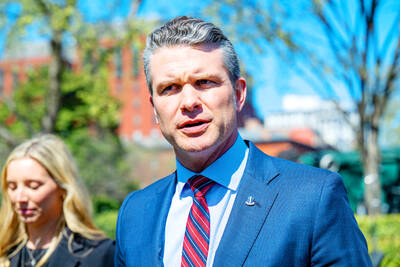Taiwan has not requested assistance from the US to overhaul its two aging US-built GUPPY-class submarines and is to carry out the project on its own, Chinese Nationalist Party (KMT) Legislator Lin Yu-fang (林郁方) said on Sunday.
Lin, who led a delegation of Taiwanese legislators to Washington earlier this month, told a press conference that the navy is capable of replacing the hulls of the two vessels, so the government has no need to seek related US support.
The maintenance is considered necessary for national security and its costs would not be a problem, Lin said.
He said the work would allow the navy to learn more about the structure of submarine hulls, which will be useful if a planned project to build submarines domestically goes ahead.
At present, Taiwan has four submarines — the two 70-year-old GUPPY, or Greater Underwater Propulsion Power Program, ships, which are used for training, and two Dutch-made subs that serve as the navy’s submarine battle force.
The navy has increased its budget for overhauling the GUPPY-class submarines from NT$450 million (US$14.9 million) to nearly NT$800 million, citing the difficulties involved.
During the discussions in Washington early this month, Taipei presented two proposals — either buying submarines from the US or building them on its own using technology provided by Washington — Lin said on Sept. 11 at a press conference.
Lin said that the indigenous submarine plan would involve replacing the hulls of the GUPPY-class submarines and upgrading their equipment.
In April 2001, then-US president George W. Bush decided to help Taiwan acquire eight diesel electric submarines, but there has been little progress since then, which has been attributed to the US no longer producing the conventionally powered vessels.

A magnitude 4.9 earthquake struck off Tainan at 11:47am today, the Central Weather Administration (CWA) said. The hypocenter was 32.3km northeast of Tainan City Hall at a depth of 7.3km, CWA data showed. The intensity of the quake, which gauges the actual effect of a seismic event, measured 4 in Tainan and Chiayi County on Taiwan's seven-tier intensity scale, the data showed. The quake had an intensity of 3 in Chiayi City and County, and Yunlin County, while it was measured as 2 in Kaohsiung, Nantou County, Changhua County, Taitung County and offshore Penghu County, the data showed. There were no immediate reports of

‘DENIAL DEFENSE’: The US would increase its military presence with uncrewed ships, and submarines, while boosting defense in the Indo-Pacific, a Pete Hegseth memo said The US is reorienting its military strategy to focus primarily on deterring a potential Chinese invasion of Taiwan, a memo signed by US Secretary of Defense Pete Hegseth showed. The memo also called on Taiwan to increase its defense spending. The document, known as the “Interim National Defense Strategic Guidance,” was distributed this month and detailed the national defense plans of US President Donald Trump’s administration, an article in the Washington Post said on Saturday. It outlines how the US can prepare for a potential war with China and defend itself from threats in the “near abroad,” including Greenland and the Panama

The Chinese Nationalist Party (KMT) is maintaining close ties with Beijing, the Democratic Progressive Party (DPP) said yesterday, hours after a new round of Chinese military drills in the Taiwan Strait began. Political parties in a democracy have a responsibility to be loyal to the nation and defend its sovereignty, DPP spokesman Justin Wu (吳崢) told a news conference in Taipei. His comments came hours after Beijing announced via Chinese state media that the Chinese People’s Liberation Army’s Eastern Theater Command was holding large-scale drills simulating a multi-pronged attack on Taiwan. Contrary to the KMT’s claims that it is staunchly anti-communist, KMT Deputy

RESPONSE: The government would investigate incidents of Taiwanese entertainers in China promoting CCP propaganda online in contravention of the law, the source said Taiwanese entertainers living in China who are found to have contravened cross-strait regulations or collaborated with the Chinese Communist Party (CCP) could be subject to fines, a source said on Sunday. Several Taiwanese entertainers have posted on the social media platform Sina Weibo saying that Taiwan “must be returned” to China, and sharing news articles from Chinese state media. In response, the Mainland Affairs Council (MAC) has asked the Ministry of Culture to investigate whether the entertainers had contravened any laws, and asked for them to be questioned upon their return to Taiwan, an official familiar with the matter said. To curb repeated